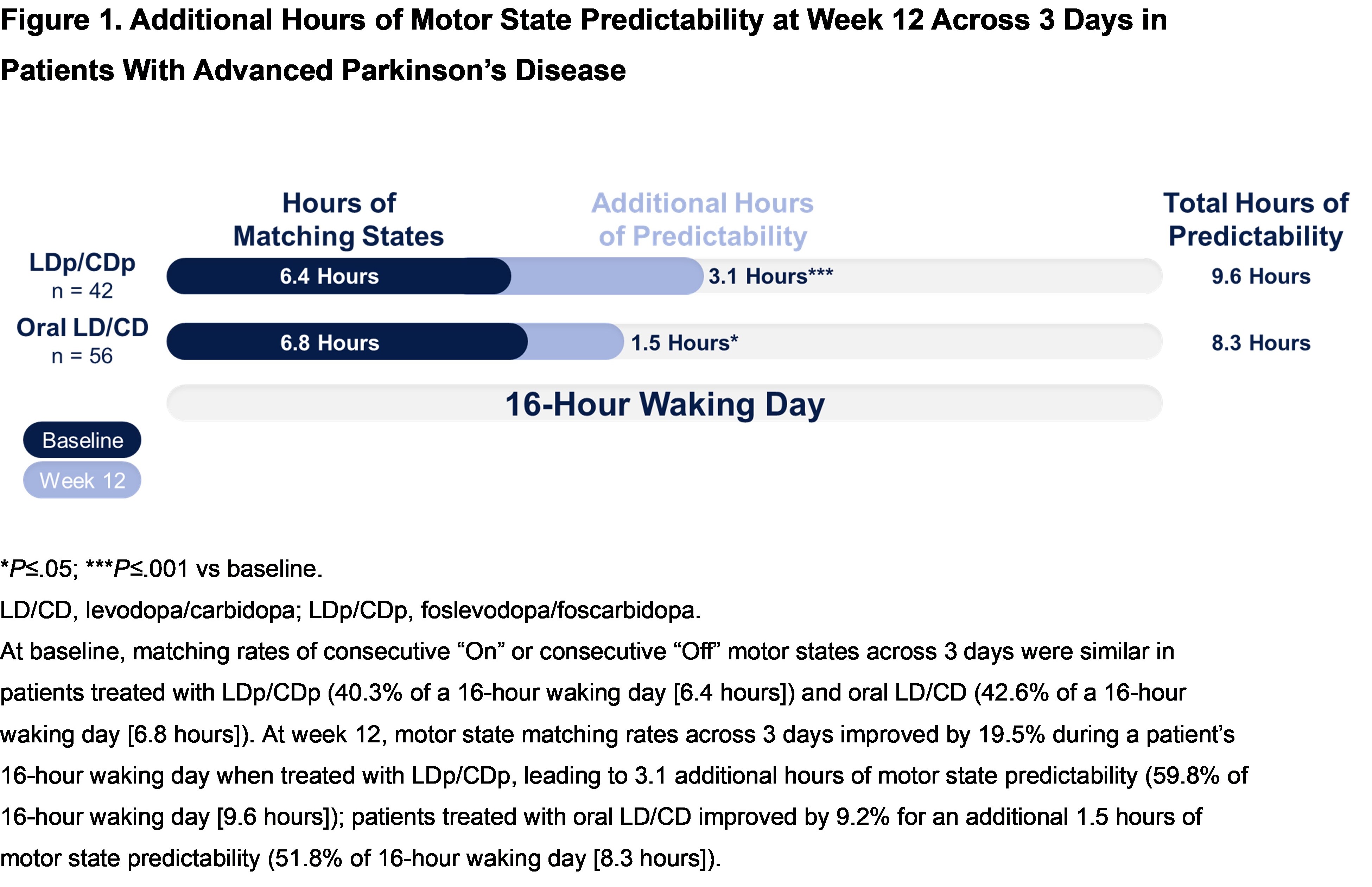Category: Parkinson’s Disease: Clinical Trials
Objective: To assess predictability of “On” or “Off” motor states in patients (pts) with advanced Parkinson’s disease (PD) treated with foslevodopa/foscarbidopa (LDp/CDp).
Background: Pts with PD may experience motor fluctuations and >2.5 hours of “Off” time per day despite treatment with oral levodopa/carbidopa (LD/CD), leading to anxiety, poorer quality of life, and difficulty in daily planning [1]. LDp/CDp is a soluble formulation of LD/CD prodrugs administered as a 24-hour/day continuous subcutaneous infusion. LDp/CDp demonstrated a significantly greater increase in “On” time and reduction in “Off” time compared with oral LD/CD in a phase 3, double‑blind, randomized, controlled trial (NCT04380142) [1]. We investigated the evolution of predictability of these motor states among pts enrolled in the study.
Method: Pts aged ≥30 years with LD-responsive, idiopathic PD inadequately controlled with oral therapies (≥2.5 hours of “Off” time/day) were randomized to receive LDp/CDp or oral LD/CD for 12 weeks. Pts completed the PD Diary on 3 consecutive days before baseline and before prespecified site visits through week 12. Pts recorded their motor state every 30 minutes throughout their 16‑hour waking day. Motor states “matched” when consecutive diary entries at the same timepoint across 2 or 3 days showed the same “On” (with or without dyskinesia) or “Off” motor state. Only pts with valid PD Diary entries at both baseline and week 12 were included in the analyses. P values, based on a 1-sample t-test, are nominal; there was no multiplicity control.
Results: LDp/CDp significantly increased the mean motor state matching rates across 2 days (n=47) from 60.1% of the time at baseline to 73.5% at week 12 (mean [SD] change from baseline of 13.4% [22.9]; P≤.001) and across 3 days (n=42) from 40.3% of the time at baseline to 59.8% at week 12 (mean [SD] change from baseline of 19.5% [31.4]; P≤.001). The mean motor state matching rates across 2 and 3 days also significantly improved with oral LD/CD treatment, but to a lesser extent. When expressed as hours of a 16‑hour waking day, predictability of “On” times or “Off” time across 3 days increased by ≈3 additional hours per day with LDp/CDp compared with 1.5 additional hours per day with oral LD/CD [figure1].
Conclusion: Treatment with LDp/CDp improves predictability of motor states, which may help pts with PD better plan their day around periods of “On” time.
Figure 1
References: 1. Soileau MJ, et al. Lancet Neurol. 2022;21:1099–1109.
To cite this abstract in AMA style:
R. Hauser, M. Bouchard, D. Santos-Garcia, L. Bergmann, R. Gupta, L. Harmer, M. Shah, C. Yan, S. Isaacson. Predictability of Motor States With Foslevodopa/Foscarbidopa in Patients With Advanced Parkinson’s Disease [abstract]. Mov Disord. 2024; 39 (suppl 1). https://www.mdsabstracts.org/abstract/predictability-of-motor-states-with-foslevodopa-foscarbidopa-in-patients-with-advanced-parkinsons-disease/. Accessed April 26, 2025.« Back to 2024 International Congress
MDS Abstracts - https://www.mdsabstracts.org/abstract/predictability-of-motor-states-with-foslevodopa-foscarbidopa-in-patients-with-advanced-parkinsons-disease/

